
Republic, 12 Chapters, 1955. Starring Phyllis Coates, Myron Healey, John Daheim, Mike Ragan, Arthur Space, Roy Glenn.
The Panther Girl of the Kongo is African-wildlife photographer Jean Evans (Phyllis Coates), who’s earned the sobriquet by delivering the Utanga tribe from a man-eating panther. However, she must now contend with another, far more unusual threat–gigantic and ferocious crawfishes that are rampaging through the jungle near the Utanga village and terrorizing the tribe. These creatures have been secretly developed by brilliant but unscrupulous chemist Dr. Morgan (Arthur Space) via a special growth hormone; the doctor intends to use the artificially-enlarged beasts to drive the Utangas from their land–which, unbeknownst to anyone but himself, contains a valuable diamond mine. In concocting this scheme, Morgan has reckoned without Jean and her intrepid ally, hunter Larry Sanders (Myron Healey); together, they repeatedly tangle with the monstrous crustaceans, while trying to find out who’s responsible for the monsters’ presence in the jungle–even though their investigation is hampered at every turn by Morgan’s henchmen Cass and Rand (John Daheim and Mike Ragan).
Panther Girl’s oversize crawfishes–obviously inspired, like the giant invertebrates in many other 1950s films, by the success of Them!–add an enjoyably novel wrinkle to the serial’s plot; instead of revolving–like the storylines of most 1950s Republic serials–around a series of equipment thefts and sabotage attempts, Panther Girl’s screenplay focuses firmly on the attempt to track down the “monsters” and prove their existence to the authorities. However, though the crawfish hunt is refreshingly offbeat, the action it gives rise to is very run-of-the-mill; writer Ronald Davidson quickly lets the narrative turn into a standard and repetitious series of clashes between the leads and the action-heavy duo, as the latter repeatedly try to kill off the hero and heroine in order to protect the crawfishes.
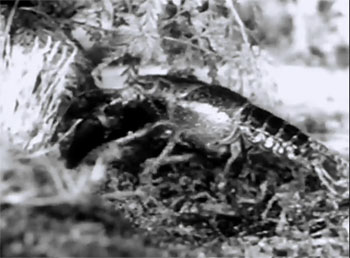

Above: A crawfish retreats before Phyllis Coates and Myron Healey’s rifle fire.
There are occasional distractions from this ongoing duel (the villains’ efforts to turn the natives against the heroine, the heroes’ discovery of the secret mine), but by and large the story stays on the same repetitious track for the bulk of its twelve-episode length; fortunately, Panther Girl’s chapter runtimes (like those of all later Republics) are short enough to ensure that individual episodes move briskly, even when the overarching plot has sadly bogged down. Davidson also takes pains to give the crawfishes some screen time in nearly every episode, which keeps the action from ever seeming completely routine; however, he inexplicably fails to use the creatures in the climactic chapter–in which he seems to be very obviously setting up Dr. Morgan for a comeuppance at the claws of one of his creations, but instead disposes of him in more ordinary fashion.
Though Panther Girl’s crawfishes have frequently been ridiculed by reviewers, they’re actually brought to life by special effects that are more than adequate by low-budget sci-fi standards; Howard and Theodore Lydecker constructed miniature jungle sets for live crawfishes to crawl around on–sets that match quite well with the terrain trodden by the serial’s life-size actors, and thus minimize the visual seam between actors and monsters quite effectively (whether they’re interacting through process-screen work or intercutting). However, the serial’s budget does limit the beasts’ activities; though they lumber menacingly through the jungle, burst out of crates, climb out of a pit, destroy a camera tripod, and periodically seize people (with the aid of a life-sized claw prop), they don’t engage in any of the large-scale destruction one expects from a 1950s filmic monster. It would have been more impressive to watch one of them rampage through a miniature of the native village, but such a sequence would probably have taken too much time and money to pull off.
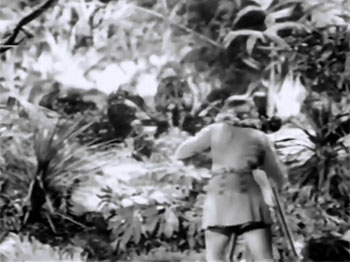
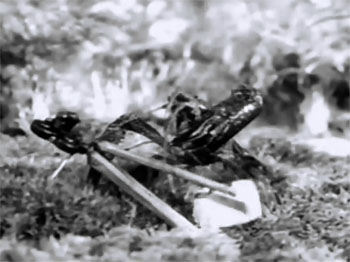
Above: Phyllis Coates tries to film a crawfish during her first encounter with one of the monsters, but loses her camera to the beast’s wrath.
The non-crawfish action is competently handled by director Franklin Adreon, who manages to keep numerous jungle gunfight scenes from being as static as they could have been–shooting them at a variety of angles and having the actors frequently change positions by racing and dodging through the undergrowth (the sequences in chapters Three and Seven are particularly good examples). However, most of the gun battles suffer from a serious flaw common to most later Republics: due to the serial’s small cast of heavies, the heroes can’t be allowed to actually score a hit on their opponents, giving a frustratingly inconclusive tone to the gunfights. That said, the villains’ native allies, the renegade “Returis,” do occasionally sustain injuries during these battles–but they appear less and less frequently as the serial progresses, leaving Cass and Rand to safely brave Jean and Larry’s fruitless firing until their bullets suddenly become effective in the final chapter.


Above: Myron Healey (left-hand picture) runs firing through the jungle in flight from Mike Ragan and his native accomplices (right-hand picture).
The serial’s fistfights are not as irksome as its gunfights. Tom Steele doubles hero Myron Healey some of the time, but the actor also does a good deal of his own stuntwork; action heavies John Daheim and Mike Ragan double themselves throughout. This diminishment of doubling–another common trait of later Republics–makes the fight scenes less elaborate and slower in tempo than the brawls in Republic’s classic efforts, but at the same time also makes them seem a bit more toughly realistic; the Chapter Four fight in Morgan’s lab (enlivened by some good close-up action), the Chapter Five mine fight, and the Chapter Seven fight between Healey and a knife-wielding Fred Graham are particularly noteworthy. The Chapter Six balcony fight and the Chapter Eleven riverbank fight are also respectable; the Chapter Nine brawl on the dock, however, is simply too tepidly paced to work, even though it’s distinguished by some good overhead shots.
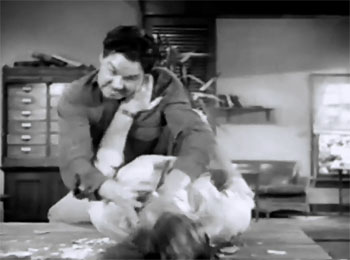

Above left: John Daheim tries to throttle Myron Healey during the Chapter Four fight. Above right: Tom Steele ducks a swung chair (which can be seen flying to splinters against a post) as he climbs to a balcony to begin a fight in Chapter Nine.
Many other action scenes in Panther Girl are cribbed from Republic’s Golden Age chapterplay Jungle Girl–most notably the repeated footage of the heroine’s spectacular vine-swinging, originally performed by stuntwoman Helen Thurston for Jungle Girl. The dramatic Chapter Five lion fight–the work of animal trainer Melvin Koontz and his lion Jackie–is also lifted entirely from Jungle Girl, as is the less striking alligator fight in Chapter Eight; stock from Republic’s first serial Darkest Africa also appears during the gorilla attack at the end of Chapter Three, combined with new footage of Steve Calvert in Ray Corrigan’s old ape suit.
The cliffhanger involving the aforementioned gorilla–with a tied-up Phyllis Coates menaced by the beast after it shrugs off Myron Healey’s rifle bullets and knocks him flying–is one of the serial’s more memorable ones; interestingly, though Panther Girl borrows many shots and several sequences from Jungle Girl, its chapter endings are largely composed of original footage. Of these, Healey’s rundown by a jeep at the end of Chapter Two and his fall from a balcony onto a harrow at the end of Chapter Six are quite good; the Chapter Ten bungalow explosion is good as well, though resolved in improbable style. The apparent drownings that close chapters Four, Nine, and Eleven are much weaker, while Phyllis Coates’ seizure by a giant crawfish’s “claw” at the end of Chapter One looks a little silly, but is sold by the actress’s realistically alarmed reaction.


Above left: Phyllis Coates is seized by a crawfish at the end of Chapter One. Above right: The jeep closes in on Myron Healey at the end of Chapter Two.
Some of the shots of the heroine atop her pet elephant are lifted from Jungle Girl, but are satisfactorily interspersed with brand-new footage of Phyllis Coates riding on a genuine pachyderm; Myron Healey gets to ride the animal a few times too. This elephant appears to be the only trained animal actually procured for the serial; the panther that appears in the Chapter One flashback is jointly portrayed by stock footage and a dummy. However, Panther Girl overall features surprisingly few of the animal stock shots seen in some of Sam Katzman’s jungle serials and in Republic’s own Jungle Drums of Africa; aside from the brief montage in Chapter Two (presented as part of the heroine’s wildlife-film collection), there’s no sequences in which the story stops for the characters to stare at stock-footage animals fighting each other or galloping through the wilds. There’s also no pet chimpanzee on hand to engage in allegedly funny monkeyshines–a remarkable but welcome omission for a B-level jungle adventure.
Despite the scarcity of wildlife, Panther Girl conveys more of a believable jungle atmosphere than many “jungle” serials–materially assisted by locations that include thickly-foliaged sections of the Republic backlot, some well-disguised soundstages, and said backlot’s tropical lagoon/river/dock (originally constructed for Republic’s big-budget feature Fair Wind to Java). The Utanga village set is also well-appointed, and is populated not only by an unexpectedly generous scattering of extras (including several women) but by a dog and some wandering chickens, which help to give it a genuinely inhabited look. Republic’s Spanish street is believable as the colonial town that figures in a few chapters, while a handful of scenes are shot under the trees of Lake Sherwood and on the cliff-edge by the Lake itself.


Above left: Morris Buchanan (in skipper’s cap) and assorted extras on the village “street.” Above right: Myron Healey’s boat approaches the “river’s” dock.
Leading lady Phyllis Coates looks terrific in Frances Gifford’s old Jungle Girl costume, and turns in a good performance as well. The grimly hostile attitude that made her unappealing (at least to me) as TV’s first Lois Lane is absent here; she manages to come off as self-reliant and gravely determined without seeming at all harsh or unpleasant. As aforementioned, her seriousness and her controlled but palpable alarm when faced with the threat of the crawfishes also helps to make those monsters seem like a credible menace. Her co-star Myron Healey, who typically specialized in portrayals of dumb, mean, and loud-mouthed heavies, is surprisingly likable in one of his only heroic roles. He’s authoritative and intimidatingly tough whenever necessary, but also conveys an easygoing cheerfulness that offsets his hard-bitten appearance and provides a good counterpoint to Coates’ gravity. His jovially exhausted demeanor (and his wry delivery of some unusually humorous dialogue) after surviving the Chapter Eight cliffhanger is particularly appealing.
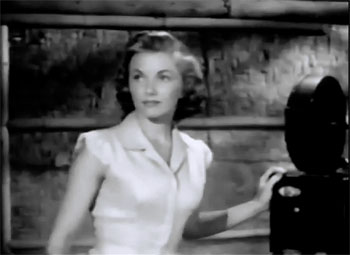

Above left: Phyllis Coates. Above right: Myron Healey.
Stuntman Johnny Daheim (billed under his “acting name” of John Day) and Mike Ragan make a fine complementary pair of action heavies; the round-faced Daheim doesn’t have a particularly villainous appearance, but makes his character (the leader of the two-man henchman team) seem formidably shrewd and resourceful, while the bulky and unfailingly crabby-looking Ragan comes off as more physically threatening but also decidedly slower-witted than his cohort. As their boss, Arthur Space turns in a much better brains-heavy turn than he did in Canadian Mounties vs. Atomic Invaders; though he occasionally lapses into the same querulousness that made his character in that serial seem more pathetic than sinister, he generally manages to convey a degree of menace in his interactions with his henchmen–adopting an intently thoughtful and coldly arrogant manner that seems appropriate to his semi-mad scientist; his bemusedly good-natured pose in his occasional interchanges with the heroes also works well.


Above left: John Daheim (dark shirt) and Mike Ragan. Above right: Arthur Space.
Roy Glenn is dignified as the worried chief of the Utangas, using his rumbling bass voice to make the most of his dialogue; Morris Buchanan is the heroine’s rather nervous chief porter, and Archie Savage is the leader of the Returi warriors. All three actors are black, as are Naaman Brown, Dan Ferniel, Martin Wilkins, and the other players cast in the serial’s minor native roles; their presence does much to augment the believable African atmosphere referred to above. The casting of genuine Britishers as colonial police officials also helps in this department; Ramsay Hill is the affably genteel commissioner, Keith McConnell a rather jaunty constable who assists the heroes in the final chapter, and James Logan a more taciturn constable who pops up in an earlier episode; Charles Sullivan plays a constable too, but, being American, is wisely given no dialogue. Gene Roth has a small role as a barkeeper, and amusingly registers dismay as a fight starts in his establishment; Fred Graham makes a brief appearance as a murderous bully hired to eliminate Myron Healey, and Alan Reynolds plays a friend of Healey’s in the opening chapter.
Panther Girl of the Kongo has received frequent drubbings from critics over the years, largely because of its oddball central premise–which admittedly sounds more than a bit absurd on paper. However, while the serial is definitely a lackluster affair, it’s really no worse than most of the other mediocre but watchable chapterplays from Republic’s last few years; its performances are good, its action scenes acceptable if very uninspired, and its “exotic” locale better-realized than one would expect. As for that central premise, it’s really no more ridiculous than those of contemporaries like Canadian Mounties vs. Atomic Invaders or King of the Carnival–and is also a good deal more colorful.

Above: Phyllis Coates and her elephant under the trees at Lake Sherwood.
Republic fanatic that I am, I found a few good things about this serial, though not as many as the reviewer. Still a great way to spend a rainy Saturday afternoon! Three stars out of five.
I also thought they did okay with the monsters, and Coates and Healey made a good pair of heroes. On the down side the villains were bland, and the shootouts flat with all the shooting and missing, plus the fights were way down from Republic’s old standard. I agree that it was disappointing that Space didn’t fall victim to one of his monsters. ** out of *****
My appreciation for this serial can be described in two words, “Phyllis Coates”. She was a beautiful, feisty heroine, who unlike other jungle girls had a real job (cinematographer). She and Myron Healey took turns saving each other, and worked well together. They could have suppressed her scream and substituted a soprano Tarzan yell like Carol Burnett. Most especially no matter what the scene she always looked HOT.
Lackluster is certainly an apt description. At this point Republic’s glory days must have seemed like a very distant memory. One more serial, the even less inspired “King of the Carnival”, would be produced before finally giving up the ghost.
The one-sheet poster for “Panther Girl” labels it “the most exciting serial ever filmed”. Talk about false advertising! One might have thought by the mid-1950’s, the filmmakers could have come up with something better than the usual, boring “jungle” stereotypes, but no such luck. There was one surprising stab at reality that I’d never seen in a Republic serial – blood on the faces of guys after a fistfight.
As with the previous commenter, my sole reason for watching was to see Phyllis Coates, one of my favorite actresses. She looked great, and she and Myron Healey had a nice chemistry together. Their scenes give the serial what little spark it manages to generate. For anyone interested, there’s a short article at the Western Clippings website (Chapter Five of their series, Serial Report) regarding her memories of making the film.
(One minor correction to the review – in the text following the title card screenshot, the year of release should be 1955.)
Thanks for the correction; it’s been remedied.